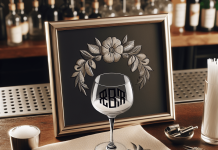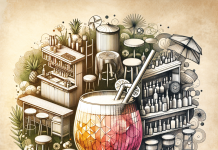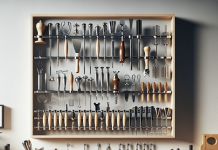Are you an aspiring home bartender or someone who enjoys the occasional cocktail? If so, you may have pondered the necessity of a cocktail shaker.
In this article, we will explore why a cocktail shaker could be a valuable tool for any cocktail enthusiast, whether a beginner or a seasoned mixologist.
From the importance of proper dilution and chilling to the art of creating a perfectly balanced drink, we’ll uncover the secrets behind the perfect cocktail and why a cocktail shaker might be the missing ingredient to elevate your home bartending experience.
Benefits of using a cocktail shaker
Better mixing and dilution
A cocktail shaker allows better mixing and dilution of the ingredients than simply stirring or muddling them. When you shake a cocktail, the ingredients are vigorously combined, creating a more uniform flavor profile and ensuring that all the flavors are well-blended.
This is particularly important when using ingredients that have different densities or consistencies, such as juices, syrups, and spirits. The shaking action also helps to incorporate air into the mixture, resulting in a lighter and frothier texture.
Enhanced presentation
Another benefit of using a cocktail shaker is the enhanced presentation it provides. When you shake a cocktail, the action creates a cool, frothy head on the drink, adding a visually appealing touch to your creation.
This frothy layer can be particularly striking when garnished with a sprig of fresh herbs, a citrus twist, or a colorful cocktail umbrella. The shaking also helps to chill the ingredients, resulting in a refreshing, cold drink that is visually inviting and pleasurable.
Efficient straining
A cocktail shaker typically comes with a built-in filter or can be easily paired with a separate strainer, allowing you to strain unwanted ingredients or ice from your drink efficiently.
This ensures the final product is smooth and free from clumps or large ice chunks that may have formed during the shaking process. This efficient straining is especially useful when using fresh fruits, herbs, or other ingredients that may leave behind residue or fibrous particles. You can quickly achieve your cocktails’ clean and professional finish with a cocktail shaker.
Improved temperature control
Using a cocktail shaker also provides improved temperature control for your drinks. When you shake a cocktail, the ice and the action of shaking rapidly chill the ingredients, resulting in a colder final product.
This is especially important for cocktails meant to be enjoyed ice-cold, such as martinis and margaritas. The rapid cooling also helps prevent the drink from diluting too quickly, allowing you to savor the flavors and enjoy a well-balanced cocktail for longer.
Types of cocktail shakers
Boston shaker
The Boston shaker consists of two separate pieces: a metal tin and a mixing glass. The metal tin is typically made of stainless steel and is more prominent in size, while the mixing glass is usually made of glass and has a smaller capacity.
Place the ingredients in the mixing glass using the Boston shaker, fit the metal tin on top, and shake the cocktail. The advantage of the Boston shaker is its versatility and the fact that you can easily see the contents of the cocktail as you shake it. It is also relatively easy to clean and maintain.
Cobbler shaker
The Cobbler shaker is a three-piece shaker consisting of a metal tin, a built-in filter, and a cap that fits over the filter. This shaker is the most commonly used among home bartenders and is often preferred for its convenience and ease of use.
To make a cocktail with a Cobbler shaker, add the ingredients to the metal tin, place the filter and cap on top, and shake the cocktail. The built-in filter eliminates the need for a separate filter, making it a popular choice for beginners or casual cocktail enthusiasts.
French shaker
The French shaker, also known as a Parisian shaker, is a two-piece shaker consisting of two metal tins that fit together snugly. Unlike the Boston shaker, the French shaker does not require a separate mixing glass. To use the French shaker, add the ingredients to one of the metal tins, fit the other tin on top, and shake.
The advantage of the French shaker is its simplicity and elegant design. It is favored by professional bartenders for its increased capacity and durability. However, lacking a built-in filter means you will need a separate strainer when pouring the cocktail into a glass.
Essential tools for mixing cocktails
Cocktail strainer
A cocktail strainer is an essential tool for mixing cocktails and is used to strain out any unwanted ingredients or ice from the shaker. Various types of cocktail filters are available, including the Hawthorne strainer and the Julep strainer.
The Hawthorne strainer features a spring coil that fits snugly over the mouth of the shaker, while the Julep strainer is a perforated metal spoon held against the shaker’s rim to strain the liquid. Both strainers effectively remove solids or ice from the cocktail, ensuring a smooth and consistent drink.
Muddler
To release their flavors, a muddler is used to crush or bruise ingredients, such as herbs, fruits, or sugar. It is commonly used in cocktails that require the extraction of oils or juices from fresh ingredients.
The muddler is typically made of wood or stainless steel and has a long handle for easy use in a cocktail shaker or glass. By muddling the ingredients before adding them to the shaker, you can enhance the aroma and taste of the cocktail, creating a more vibrant and flavorful drink.
Bar spoon
A bar spoon is a slender spoon for stirring and layering cocktails. Thanks to its twisted handle design, it is an essential tool for mixing ingredients in a cocktail shaker and can also be used to measure small amounts of liquid.
The length of the spoon allows for easy mixing of ingredients in a tall glass or shaker, ensuring that all the flavors are well incorporated. Additionally, the spoon’s twisted handle can create layered cocktails by slowly pouring the ingredients over the back of the spoon, allowing them to rest on top of each other.
Jigger or measuring tool
A jigger or measuring tool accurately measures the quantities of ingredients for a cocktail. It typically consists of two cups with different volumes, allowing for precise measurements of large and small amounts of liquid.
The jigger is vital to ensure that the cocktail has the right balance of flavors and proportions. It eliminates the guesswork in measuring ingredients and helps you achieve consistent results every time. Whether you prefer a traditional metal jigger or a modern measuring tool with predefined measurements, having a reliable measuring tool is essential for mixing cocktails.
When a cocktail shaker is not necessary
Simple mixed drinks
A cocktail shaker is not necessary for simple mixed drinks that do not require the vigorous mixing or chilling that a cocktail shaker provides, such as a whiskey on the rocks or a basic gin and tonic.
These drinks can be easily prepared by pouring the ingredients directly into the glass with ice and stirring it with a spoon or swizzle stick. The focus for these drinks is more on the quality of the ingredients and the presentation rather than the mixing technique.
Layered cocktails
Layered cocktails, or pousse-cafés, are drinks with multiple layers of different-colored liquids that do not mix. These cocktails rely on carefully pouring each layer over the back of a spoon to achieve the desired effect.
In this case, a cocktail shaker would not be necessary as the focus is on visual presentation rather than mixing ingredients. A steady hand and a little practice with layering techniques can create stunning layered cocktails without needing a shaker.
Stirred cocktails
Some cocktails, such as the classic martini or a Manhattan, are traditionally stirred rather than shaken. Stirring these cocktails offers a gentler mixing action that allows the flavors to blend without incorporating too much air or dilution.
A mixing glass and a bar spoon are sufficient for these drinks as they do not require the same agitation as shaken cocktails. Stirring also helps to maintain the clarity of the drink, which is preferred for cocktails that showcase the color and appearance of the spirits used.
Key features to consider when choosing a cocktail shaker
Material
Cocktail shakers come in various materials, including stainless steel, glass, and plastic. Stainless steel is the most popular choice among professionals and enthusiasts due to its durability and ability to retain cold temperatures during shaking.
Glass shakers offer an elegant presentation, allowing you to see the contents of the cocktail as you shake it, but they may be more fragile and prone to breakage. Plastic shakers are lightweight and often come with built-in measurements, making them a convenient choice for beginners or casual users.
Size and capacity
Consider the size and capacity of the cocktail shaker based on your needs. More miniature shakers are ideal for mixing individual cocktails, while more giant shakers are suitable for making multiple servings simultaneously.
Choosing a size that allows enough room for ice and ingredients to be shaken appropriately without the risk of spillage is essential. Remember that a giant shaker may require more effort to shake, especially if it becomes too heavy when filled.
Ease of use
Choose a cocktail shaker that is easy to use and comfortable to handle. Look for shakers with a secure and leak-proof seal to prevent any spills or accidents during shaking. Shakers with a well-designed grip and ergonomic shape will make the shaking process more comfortable and efficient.
Consider factors such as the weight and balance of the shaker to ensure that it is easy to control and maneuver wildly when shaking for an extended period.
Durability
Durability is essential when choosing a cocktail shaker, especially if you plan to use it frequently. Stainless steel shakers are known for their strength and resistance to dents and scratches.
Glass shakers should be made from thick and sturdy glass to prevent breakage. Plastic shakers should be made from high-quality, food-grade plastic that can withstand regular use and cleaning without cracking or warping.
Versatility
Consider the versatility of the cocktail shaker and whether it can be used for various cocktails. Some shakers come with built-in measurements or markings to make it easier to follow recipes.
Others may have additional accessories or attachments, such as a muddler or a strainer, that can enhance the functionality of the shaker. Choosing a versatile shaker will allow you to experiment with different cocktails and techniques without additional tools or equipment.
Common mistakes to avoid when using a cocktail shaker
Overfilling the shaker
One common mistake when using a cocktail shaker is overfilling it with ingredients. Overfilling can prevent mixing and dilution, leading to an imbalanced or uneven drink.
To avoid this, leave enough room in the shaker for the ingredients to move and mix when shaken freely. As a general rule, fill the shaker no more than two-thirds full to allow for proper agitation and expansion of the ingredients.
Using the wrong type of shaker
Using the wrong type of shaker can also result in difficulties and frustration. Each type of shaker has its unique design and proper use requirements. Using a Boston shaker without a proper seal or not aligning the two pieces correctly can lead to leaks and spills.
Similarly, using a Cobbler shaker without adequately closing the cap or not aligning the filter can result in a messy and inefficient straining process. Take the time to familiarize yourself with the specific instructions for your chosen shaker and use it accordingly.
Not correctly sealing the shaker
Properly sealing the shaker is crucial to prevent leaks or spills during shaking. Failing to seal the shaker tightly can result in a messy and potentially dangerous situation.
Ensure the shaker is securely closed by firmly pushing the two pieces together or correctly lining up the cap and filter. Give the shaker a gentle twist or tap to confirm it is tightly sealed before shaking. This extra step will prevent liquid from escaping and ensure a smooth mixing experience.
Shaking for too long or aggressively
Shaking a cocktail for too long or with too much force can result in over-dilution and a frothy texture that may not be desired for specific cocktails. The duration and intensity of shaking should be adjusted depending on the ingredients and the desired outcome.
As a general guideline, shake a cocktail containing fruit juices, egg whites, or dairy for about 15-20 seconds. A short shake of 10-15 seconds is sufficient for cocktails without those ingredients. Experiment with different shaking techniques to find the right balance for each cocktail recipe.
Alternatives to using a cocktail shaker
Mixing with a glass and a spoon
If you don’t have a cocktail shaker, you can use a glass and a spoon as an alternative method for mixing your drinks. Simply add the ingredients to a sturdy glass, fill it with ice, and use a bar spoon to stir the mixture for about 20-30 seconds.
Stirring will provide a gentler mix than shaking but will still allow the flavors to blend. Remember that using a glass may not provide the same temperature control or dilution level as a cocktail shaker.
Using a Mason jar
A Mason jar can serve as a makeshift cocktail shaker in a pinch. It provides a sturdy and leak-proof container for mixing ingredients. To use a Mason jar, add the ingredients, seal it tightly with the lid, and shake vigorously.
The jar’s wide opening allows easy pouring and straining using a separate filter or even the lid with some holes poked in it. However, remember that a Mason jar may not provide the same finesse or presentation as a specialized cocktail shaker.
Using a blender
A blender can be an alternative to a cocktail shaker for cocktails, such as frozen margaritas or blended daiquiris. Blenders are handy when working with ingredients that need to be crushed or blended, such as ice or frozen fruits.
Simply add the ingredients to the blender, pulse or blend until smooth, and pour into glasses. While a blender can provide a consistent and refreshing texture, it may not be suitable for all cocktails and may require additional cleanup compared to a cocktail shaker.
Cocktail shaker maintenance and cleaning
Basic cleaning steps
Regular cleaning is essential to maintain and maintain your cocktail shaker in good condition. After each use, rinse the shaker with warm water to remove residual ingredients. Use a brush or sponge to gently scrub the inside of the shaker to remove any stubborn residue.
Avoid using abrasive cleaners or harsh chemicals that can damage the surface of the shaker. Dry the shaker thoroughly before storing it to prevent moisture or odors from accumulating.
Deep cleaning for different types of shakers
For stainless steel shakers, occasional deep cleaning is recommended to remove stains or odors. Mix equal vinegar and warm water in the shaker and let it soak for about 15 minutes.
Then, scrub the inside of the shaker with a brush or sponge to remove any remaining residue. Rinse thoroughly with warm water and dry completely.
Glass shakers can be cleaned using warm water and mild dish soap. Fill the shaker with soapy water and use a brush or sponge to clean the inside. Rinse thoroughly with warm water and dry carefully to avoid any breakage.
Plastic shakers can be cleaned with warm, soapy water or in the dishwasher, depending on the specific instructions provided by the manufacturer. Check for any specific cleaning recommendations to ensure the longevity of the plastic shaker.
Storing the shaker properly
To prolong the lifespan of your cocktail shaker, it is essential to store it properly. After cleaning and drying the shaker, ensure it is scorched before storing it. Moisture trapped inside the shaker can lead to mold or mildew growth.
Store the shaker in a cool, dry place, preferably with some ventilation to prevent unwanted odors or condensation. Store the shaker separately from other metal objects to prevent any potential scratching or damage.
Popular cocktails that require a cocktail shaker
Martini
The classic martini is perhaps one of the most famous cocktails that call for a cocktail shaker. The combination of gin (or vodka) and dry vermouth is typically stirred or shaken, depending on personal preference.
Shaking the martini will chill the ingredients and create a frothy texture while stirring, resulting in a smoother, more velvety drink. Garnish with an olive or a twist of lemon peel for an elegant presentation.
Margarita
The margarita is a refreshing cocktail with tequila, lime juice, and orange liqueur. Shaking the ingredients in a cocktail shaker with ice not only chills the drink but also helps to incorporate air and create a frothy texture.
The result is a tangy and vibrant cocktail perfect for enjoying on a hot summer day. Serve in a salt-rimmed glass with a wedge of lime for added flavor.
Cosmopolitan
The Cosmopolitan, also known as a Cosmo, is a famous cocktail made with vodka, cranberry juice, orange liqueur, and lime juice. Shaking the ingredients in a cocktail shaker ensures the flavors are well-mixed and the drink is properly chilled.
The bright pink color and the frothy texture of the Cosmo make it a visually appealing and delicious choice for a night out or a special occasion.
Daiquiri
The daiquiri is a classic rum cocktail that consists of rum, lime juice, and simple syrup. Shaking these ingredients in a cocktail shaker with ice ensures the flavors are well-blended and the drink is properly chilled.
The shaking action also creates a frothy texture that adds to the overall enjoyment of the cocktail. Serve in a chilled glass and garnish with a lime wheel for a tropical and satisfying drink.
Negroni
The Negroni is a timeless and sophisticated cocktail that combines equal parts of gin, sweet vermouth, and Campari. Shaking the Negroni is unnecessary as it is traditionally stirred to preserve the clarity of the drink. The gentle stirring action allows the flavors to meld together without incorporating excessive air or dilution. Garnish with an orange twist for a touch of elegance.
Conclusion
While a cocktail shaker is unnecessary for every drink, it offers numerous benefits that enhance the mixing experience and contribute to a well-balanced and visually appealing cocktail.
The better mixing and dilution achieved through shaking, efficient straining, and improved temperature control make a cocktail shaker a valuable tool for any home bartender or enthusiast.
When choosing a cocktail shaker, consider the material, size, ease of use, durability, and versatility to ensure that it meets your needs and preferences. Also, be mindful of common mistakes to avoid when using a shaker, such as overfilling, using the wrong type of shaker, not correctly sealing it, or shaking too long or aggressively.
Suppose you find yourself without a cocktail shaker. In that case, alternatives are available, such as mixing with a glass and a spoon, using a Mason jar, or using a blender for specific cocktails. However, these alternatives may not provide the same finesse and control as a specialized cocktail shaker.
Proper maintenance and cleaning are essential for the longevity of your cocktail shaker. Follow the recommended cleaning steps for your specific type of shaker and store it in a cool, dry place to prevent any damage or odors.
Finally, explore the cocktails that specifically call for a cocktail shaker, such as the martini, margarita, cosmopolitan, daiquiri, and Negroni. These popular cocktails showcase the benefits of using a shaker, creating well-mixed, refreshing, and visually appealing drinks.
So, the next time you enjoy a cocktail, consider adding a cocktail shaker to your collection of bar tools. Its ability to mix, chill, strain, and enhance the presentation of your drinks will surely elevate your cocktail-making experience. Cheers!













































